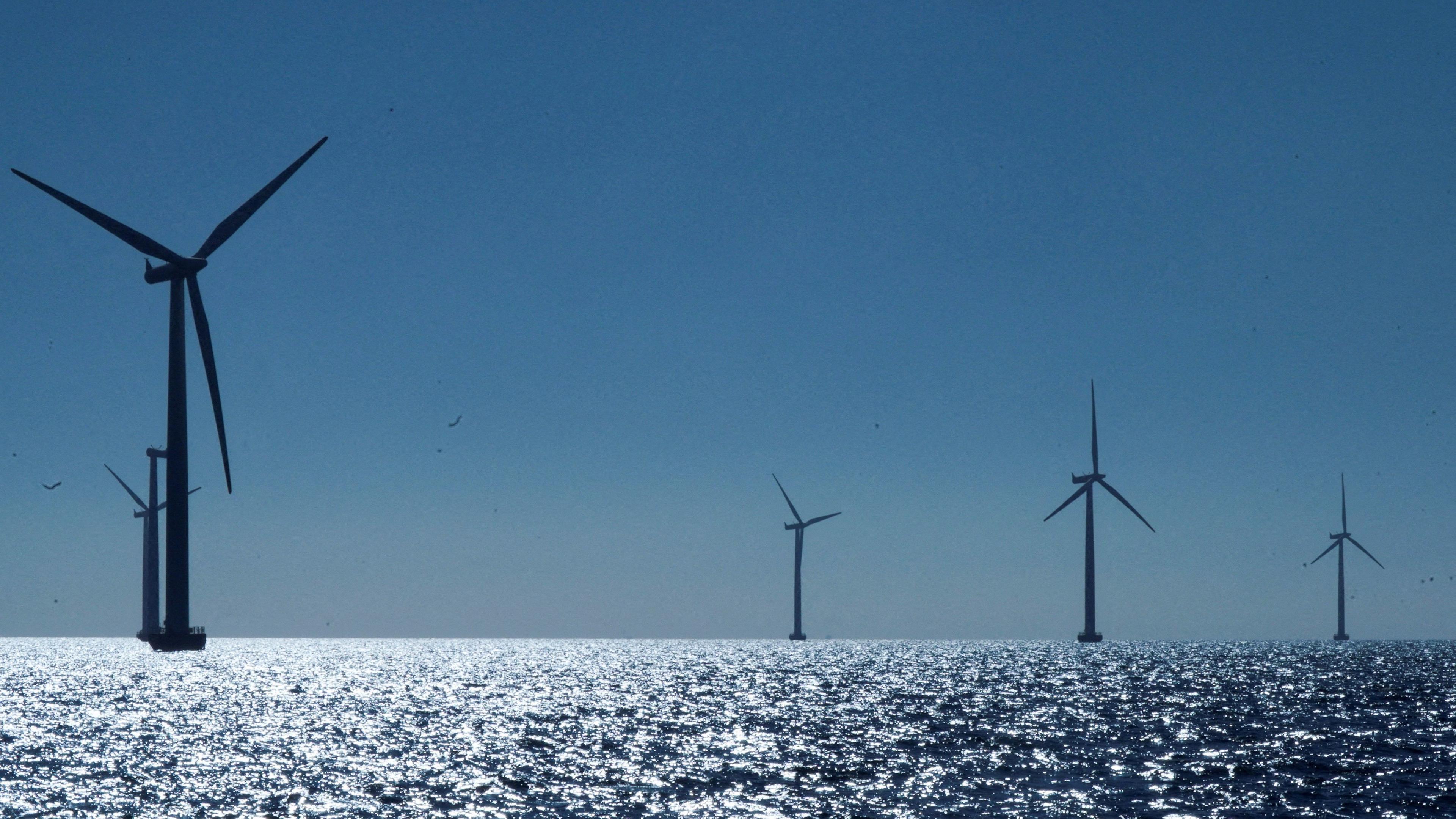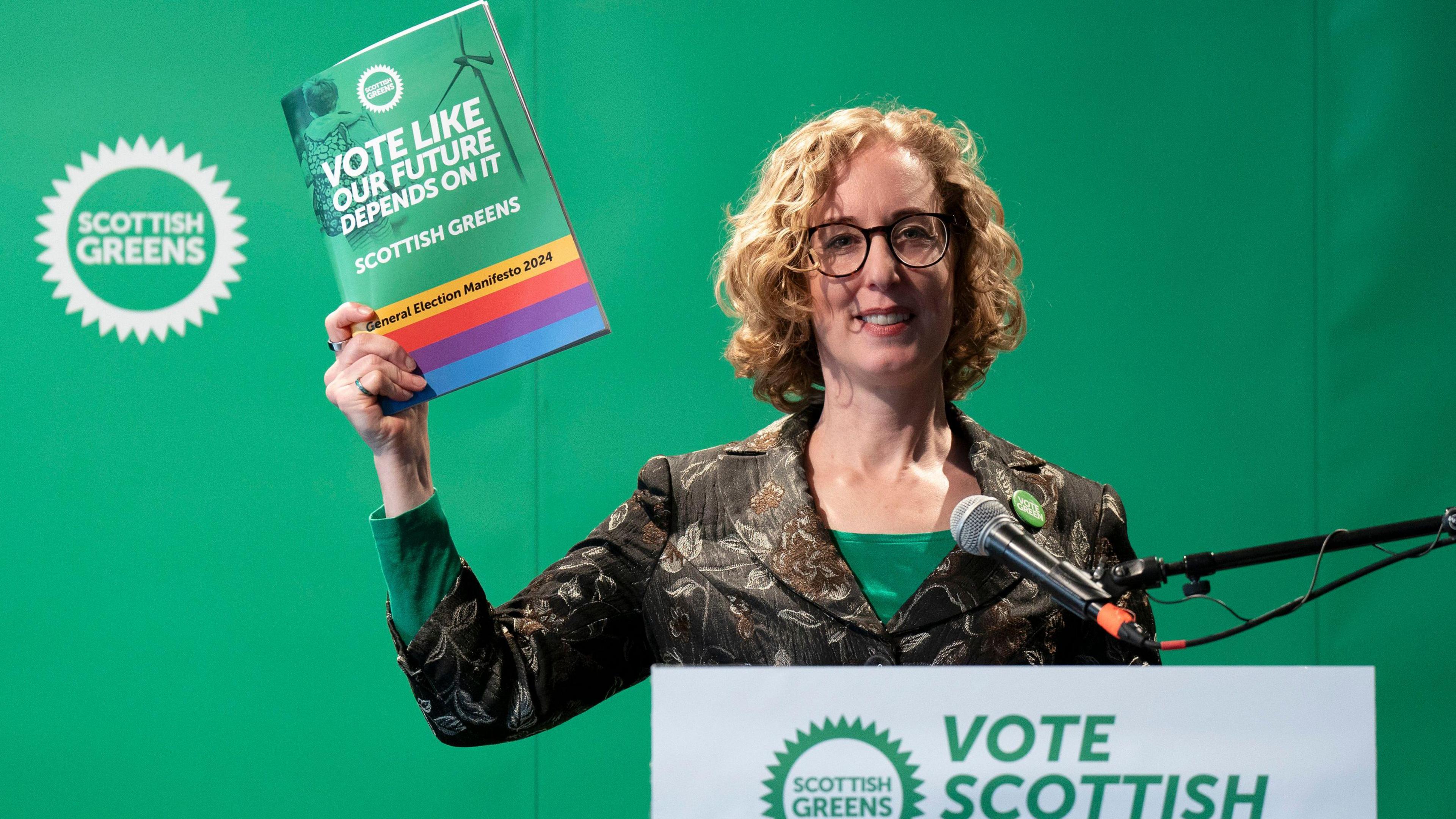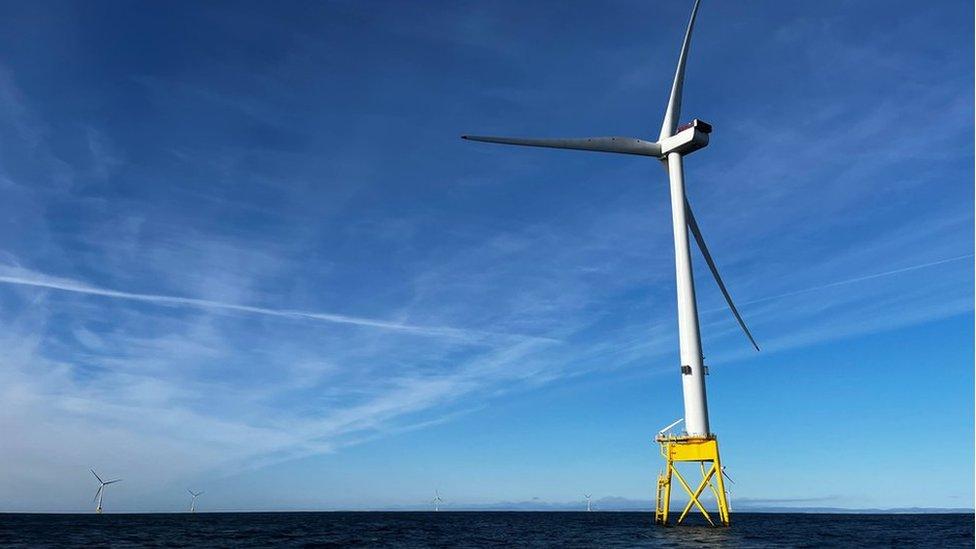What would 'GB Energy' mean for Scotland's green economy?

Governments can help with large infrastructure projects such as this one off the coast of Denmark
- Published
There are common themes running through all the manifestos, and one of them is green energy.
With the exception of Reform, which does not buy into the drive towards net zero greenhouse gas emissions, the others see renewable power as a big and ripe economic opportunity, with different approaches to tapping it.
Labour makes a big play of setting up GB Energy. According to Scottish leader Anas Sarwar, this will be "a publicly-owned clean power company, to create good jobs and cut bills for good. And will be headquartered here in Scotland".
A more precise location is yet to be given but he hinted at his manifesto launch that the decision could be connected to constituency results on the morning of 5 July.
If this sounds like an energy supplier, to provide your home with electricity and gas more cheaply than big, profitable, private companies, then think again. The route to cutting your bill is not as clear as the promise sounds.
This is what the manifesto says:
"GB Energy will partner with industry and trade unions to deliver clean power by co-investing in leading technologies; will help support capital-intensive projects; and will deploy local energy production to benefit communities across the country. To support this, Labour will capitalise GB Energy with £8.3bn over the next parliament."
In other words, it will join with private sector investors to build and own renewable energy production. And at that scale of funding, it is unlikely to be the lead developer.
The manifesto goes on to say that this publicly-owned investment fund is intended to go big, to build up supply chains in Britain, to invest in newer tech such as hydrogen. And also to get local:
"GB Energy will partner with energy companies, local authorities, and co-operatives to install thousands of clean power projects, through a combination of onshore wind, solar and hydropower projects."
The target is for 20,000 such projects. Already, GB Energy's remit is looking stretched and it’s some way from getting started. That £8.3bn over five years is expected to do some heavy lifting.

Energy is a global market requiring cross-border infrastructure
But is GB Energy needed to make investment happen? Does it add value to the private funds already going into renewable power?
The UK Government says £300bn has already been pumped into low-carbon investment, a very large share of that private money. A further £100bn is expected by 2030.
There's no shortage of private funds available if the investment conditions are right. GB Energy's contribution, after meeting its numerous other objectives, looks modest by comparison.
What developers are more likely to seek from government is co-ordination of much more grid capacity, consents to access the grid and the auctioned contracts which provide a floor price.
They would also prefer more consistent policy-making. In recent years, they have seen Treasury support for carbon capture put on the table and removed, then put back out to competitive bids, as well as windfall tax on older windfarms.
Mr Sarwar has suggested one purpose of GB Energy's investment is to help reduce risk for bigger investors, reassuring them that the UK Government has some "skin in the game", so it has a financial interest in consistency.
Where government investment can be more useful still is in backing projects and technology that do not yet stack up commercially. That can also be done through a more generous floor price, for new hydro or tidal power, for instance.
And government can invest in infrastructure, without which private investors won't commit. That is already happening, with UK and Scottish government investment funds working together on funding the huge Ardersier quayside yard near Inverness.
Who should I vote for and what are the parties promising?
- Published3 July 2024
From a more detailed Labour policy document on GB Energy, it becomes clear that the model for this is the majority state-owned energy companies such as EDF in France, Orsted in Denmark and Equinor in Norway – very large and well-established companies which generate profit for the public purse.
It states: "A driving motivation for GB Energy will be the need to emulate the success of other European countries and have our own domestic champion, building it in Britain."
This not only fits with Labour's long-standing sympathies with state enterprise, but also with the language of "mission-driven government", championed by the London-based economist Professor Mariana Mazzucato.
She argues that governments do more than most of us realise to nurture private sector success, so it ought to be a more explicit part of the process and co-ordinate efforts towards big goals, such as net zero emissions.
What, though, of that claim that GB Energy will "cut bills for good"? That is a good selling point to voters, but it's harder to make that connection.
It seems to depend on the assertion that renewable energy is cheaper than fossil fuels. That depends, in turn, on the form of renewable energy, on the amount loaded on to bills in subsidy, and on the price of fossil fuels.
The latter is volatile. The gas price has fallen a long way in the past two years, and it's not certain that renewables will remain cheaper "for good".
There is no mechanism mentioned that indicates the the power generated by a GB Energy turbine would be any cheaper for customers than any other turbine.
Nor is it clear how this fits with Scottish Labour's support for a new generation of nuclear power north of the Border. If it is priced like the new nuclear plants being built in England and Wales, it could put bills up – if not for good, then for a long time.

Anas Sarwar and Sir Keir Starmer launched Labour's "mission" on cheaper green energy in Edinburgh
So is this one area in which Labour is taking the state enterprise road in a way that Conservatives would not even contemplate?
Well, no. Twelve years ago, the Conservative-LibDem coalition set up the Green Investment Bank and headquartered it in Edinburgh, to “accelerate the UK’s transition to a greener, stronger economy” by investing in green projects.
It committed more than £8 billion of co-investment funds to 100 projects, and by 2017, it had deployed £1.5 billion of that, attracting £2.50 of private funds for every £1 it committed.
However, only three-and-a-half years after setting it up, the Treasury started the process of selling it off, in a bid to get debt off the government's books.
The sale did not go well. It took nearly 18 months to complete, at a profit of only £186m. From 2017, the Green Investment Group was part of the Macquarie group of investment funds, based in Australia. The Edinburgh headquarters and any remaining autonomy was rolled into Macquarie in 2022.
The National Audit Office (NAO), Whitehall's spending watchdog, investigated the short-lived government investment bank and its sale, and was not complimentary, external in its findings.
The NAO concluded : "Ultimately the value for money of the Green Investment Bank intervention will only be seen over time.
"A key test will be whether the Government needs to intervene again in this way to stimulate growth in the green economy and to help it achieve its climate change commitments”
Labour says it does, and it will. The story of the Green Investment Bank offers some useful lessons in how not to do it.
Related topics
- Published20 June 2024

- Published17 October 2023

- Published17 June 2024
